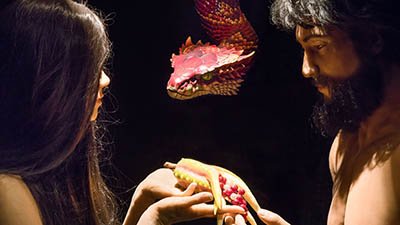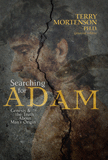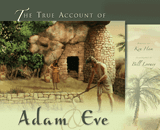
The Necessity of Believing in a Historical Adam
In recent years, in an effort to harmonize the evolutionary story and timeline with Scripture, a growing number of professing evangelicals have been doubting or denying Adam’s existence or at least denying some of the details about Adam in Genesis. Some would even seek to cast Genesis 1–11 as a poetic myth that does not accord with historical reality. But do these attempted harmonizations work, and does it matter what we believe about Adam?
The Historicity of Adam
Genesis 1–11 is inerrant history, not poetry, historical fiction, or mythology.1 There are several reasons to conclude this. The Hebrew word toledoth (translated as history, account, or generations) occurs 13 times in Genesis.2 This ties the book together as a unified whole covering the time from creation week to the beginning of the Israelites’ sojourn in Egypt. The waw-consecutive verb form dominates Hebrew historical narrative, and it does so right from the beginning of Genesis 1.3
The genealogies in Genesis 5 and 11 connect Adam to Abraham, and all evangelical scholars treat Abraham as historical. First Chronicles 1–8 confirms the genealogical history in Genesis 1–11 and the rest of Genesis and then provides more genealogies. This shows that the Jews (and God who inspired the text) were very concerned to preserve this historical record of real people: certain Israelites from David back to Abraham and then the patriarchs back to Adam.
In their gospels, Matthew and Luke continue this concern for genealogical history. Luke takes us from Jesus all the way back to Adam, who (like Jesus) had a supernatural origin with no physical father (Luke 3:23–38). All the men in these genealogies that end with Adam are undoubtedly real historical people. Adam (and the details about him) must therefore be historical, or these men are descended from a myth.4
When the New Testament authors refer to Genesis 1–11, they always take the details in Genesis as literally accurate history.
When the New Testament authors refer to Genesis 1–11, they always take the details in Genesis as literally accurate history. Paul affirmed that Adam was the first man (1 Corinthians 15:45 and 47), that Eve was made after, from, and for Adam (1 Corinthians 11:8–9; 1 Timothy 2:13), and that Eve was deceived (1 Timothy 2:14; 2 Corinthians 11:3). Given how much Paul refers explicitly or implicitly to Satan (2 Corinthians 2:11, 4:3–4, 11:13–15; Ephesians 6:11; 2 Thessalonians 2:8–9) and given that he would have believed Revelation 12:9, it is certain that Paul believed that Satan spoke through that crafty serpent, just as God spoke through Balaam’s donkey (Numbers 22:28).5 Paul also affirmed that as descendants of Adam we are all blood relatives in the one human race, regardless of skin shades or ethnicity (Acts 17:26).6
Peter believed the detail that only eight people were saved from the flood (1 Peter 3:20; 2 Peter 2:5) just as he did the detail that Sodom and Gomorrah were burned to ashes (2 Peter 2:6). Peter also believed the flood was a global watery judgment, just as the judgment by fire at the return of Christ will also be global (2 Peter 3:3–7). And both Peter and Paul made it very clear that they knew the difference between truth and myth.7
Therefore, we should take Genesis 1–11 as literally as we do the accounts of the virgin birth, crucifixion, and resurrection of Jesus. So what do they teach us about the origin of man and his relationship to the rest of creation?
The Literal Truth About Adam
According to Genesis 1:26–30, Adam and Eve were created on the sixth literal day of history and were uniquely made in the image of God.8 They were created to rule over the rest of creation. Genesis 2:7–25 tells us that Adam was created with the ability to understand and use spoken language. He had the intelligence and reasoning ability to name animals and discern that he was alone—the only human being, until God made Eve.
In Genesis 2:7, God says, “Then the LORD God formed the man of dust from the ground and breathed into his nostrils the breath of life, and the man became a living creature.” Clearly stated, God made the first male (’adam) from the dust of the ground (’adamah), added the divine breath, and Adam became a “living creature” (nephesh chayyah).9 The same words, nephesh chayyah, describe sea creatures, flying creatures, and land animals in Genesis 1:20–21 and 24, 2:19, and 9:9–15. They are all living creatures (though they are not made in the image of God as Adam and Eve and all subsequent humans were). Genesis 2:7 is impossible to harmonize with human evolution. God did not make a living creature by natural processes over millions of years and transform that living creature into a human being. Adam was made supernaturally from literal dust (cf. 1 Corinthians 15:45–47).
Genesis 2:22 is likewise critically important. Unlike Adam, the first woman, Eve, was made from a preexisting living creature (Adam). However, she too was not created by any natural process, but rather by supernatural surgery.
The fall of Adam and Eve in Genesis 3 not only produced immediate spiritual death (Genesis 3:8). It precipitated God’s judgment in cursing the nonhuman creation (Genesis 3:14, 17–18) and initiating the physical death process in humans (Genesis 3:19). God also gave the first promise of the coming Messiah to save sinners (Genesis 3:15). Pointing to the fulfillment, God made coats of skin for them implying the first blood sacrifice as a covering for sin (Genesis 3:21), a picture of what would come through the Lamb of God (Jesus) who gives forgiveness of sin (John 1:29). Then God expelled them from the garden of Eden to live in a fallen, cursed creation (Genesis 3:23).
Does It Matter What We Believe About Adam?
Because Adam and Eve are the parents of the human race and were made supernaturally and in the image of God, it means that we are not animals. Since Scripture clearly teaches that human life begins at conception (i.e., fertilization), abortion is murder. Adam and Eve were commanded to rule over the creation (wisely and benevolently as vice-regents, accountable to God). So people are more important than the creation, which has profound relevance to our view of environmental issues.
God made Adam and Eve and created marriage, which is foundational to Scripture’s teaching that there are only two genders, sexual relations are only within marriage, and marriage (exclusively) between one man and one woman is to be a lifelong covenant. Therefore adultery, fornication, rape, polygamy, pornography, the ideology-associated behaviors and “orientations,” and transgender medical “treatments” of the LGBTQ+ movement are wrong.
Given the literal truth about Adam and Eve, we must conform our thoughts and actions to the fact that there is only one race. And genetics confirms this truth. The differences between us are literally skin deep. So racism is wrong.
Referring to Genesis 1–2 in Mark 10:1–9, Jesus affirmed that God created marriage and two genders but also that Adam and Eve were at the “beginning of creation.”10 Paul likewise taught that “since the creation of the world,” humans have seen the witness of creation to the existence and some attributes of God (Romans 1:20). Jesus and Paul were clearly young-earth creationists: Adam was not created billions of years after the beginning, as implied by the evolution story.
Most importantly, the gospel requires the literal history of Genesis 1–11.
Most importantly, the gospel requires the literal history of Genesis 1–11. Adam brought sin and physical and spiritual death into the human race. But Jesus came as the “last Adam” to give spiritual life and ultimately resurrected physical life to all those who repent of their sins and trust in Jesus Christ as Savior and Lord (Romans 5:12–21; 1 Corinthians 15:20–28, 42–50). Because of the first Adam’s sin, the whole creation is now groaning in bondage to corruption and waiting to be set free from the curse at the second coming of the last Adam (Romans 8:18–25; cf. Acts 3:21; Revelation 22:3).11
Many old-earth creationists have expressed their opposition to theistic evolution and have affirmed a literal historical Adam. In other words, they accept the big bang and billions of years of earth history, but they reject biological (and human) evolution. Sadly, however, as I have shown elsewhere in the case of Wayne Grudem (an old-earth proponent),12 many of their objections against theistic evolution are also reasons for rejecting all old-earth views in the church.13
Conclusion
Rejecting a literal, historical Adam—or some of the details about him and Eve—undermines the authority of Scripture and has enormous theological and moral implications. Millions of years of animal disease, death, extinction, and other natural evils before Adam undermines the clear truth of God’s Word and thereby undermines the credibility of the gospel. The historical last Adam came to solve the real, historical problem caused by the historical first Adam. We can’t have the gospel without the last Adam, but we can’t have the gospel without the first Adam either. “Let God be true though every one were a liar” (Romans 3:4)!
Reproduced with permission from Christ Over All, https://christoverall.com/article/concise/the-necessity-of-believing-in-a-historical-adam/ on February 12, 2025.
Footnotes
- Even most old-earth proponents in the church recognize that Genesis 1–11 is history. See, for example, the arguments in Walter Kaiser, The Old Testament Documents: Are They Reliable and Relevant? (Downers Grove, IL: IVP, 2001), 53–83.
- See Genesis 2:4, 5:1, 6:9, 10:1, 10:32, 11:10, 11:27, 25:12, 25:13, 25:19, 36:1, 26:9, and 37:2.
- See Stephen W. Boyd, “The Genre of Genesis 1:1–2:3: What Means This Text?,” in Terry Mortenson and Thane H. Ury, eds., Coming to Grips with Genesis: Biblical Authority and the Age of the Earth (Green Forest, AR: Master Books, 2008), 163–192.
- For arguments that Genesis 5 and 11 are tight, chronogenealogies (no missing names or gaps of time), showing that the age of the creation is only a little more that 6,000 years, see my chapter 5 in Searching for Adam and this article critiquing Hugh Ross’ constantly changing dates for the creation of Adam.
- Christians who treat the accounts of the talking serpent and talking donkey as fictional, mythical stories (i.e., they deny that a supernatural being made an animal talk) have no logically or exegetically consistent basis to believe any miracle in the Bible, including the virgin birth and resurrection of Jesus.
- To see that Adam, and not Noah, is in view, see Simon Turpin’s analysis here.
- The Greek word for myth (mythos) is contrasted with the truth in 2 Timothy 4:4 and Titus 1:14. See also 1 Timothy 1:4 and 4:7 and 2 Peter 1:16 where mythos is used, clearly in contrast to truth.
- For a scholarly defense of the young-earth view of Genesis 1–11 that is also understandable to thoughtful lay people, see the 14-author work, Terry Mortenson and Thane H. Ury, eds., Coming to Grips with Genesis (Green Forest, AR: Master Books, 2008).
- These Hebrew words, which the ESV translates as “living creature,” are translated in this verse as “living being” (NASB, NIV, NKJV, CSB) or “living soul” (KJV), though elsewhere in Genesis these various translations render nephesh chayyah as “living creature.”
- See here for a short defense of this point. For a longer discussion, see this article, which is similar to my chapter 11 in Coming to Grips with Genesis.
- See Simon Turpin, “Did the Fall Have Consequences on Creation? Romans 8:18–22.” For a more in-depth defense, see Henry B. Smith, Jr., “Cosmic and Universal Death from Adam’s Fall: An Exegesis of Romans 8:1–23a,” Journal of Creation 21, no. 1 (2007), 75–78.
- See my short critique of Grudem’s two chapters in Theistic Evolution: A Scientific, Philosophical, and Theological Critique (Crossway, 2017). For an in-depth documentation of his inconsistent thinking, see here.
- See also my online lecture “Millions of Years: The Idea’s Unscientific Origin and Catastrophic Consequences” and my article “The Fall and the Problem of Millions of Years of Natural Evil.”
Recommended Resources

Answers in Genesis is an apologetics ministry, dedicated to helping Christians defend their faith and proclaim the good news of Jesus Christ.
- Customer Service 800.778.3390
- Available Monday–Friday | 9 AM–5 PM ET
- © 2025 Answers in Genesis




